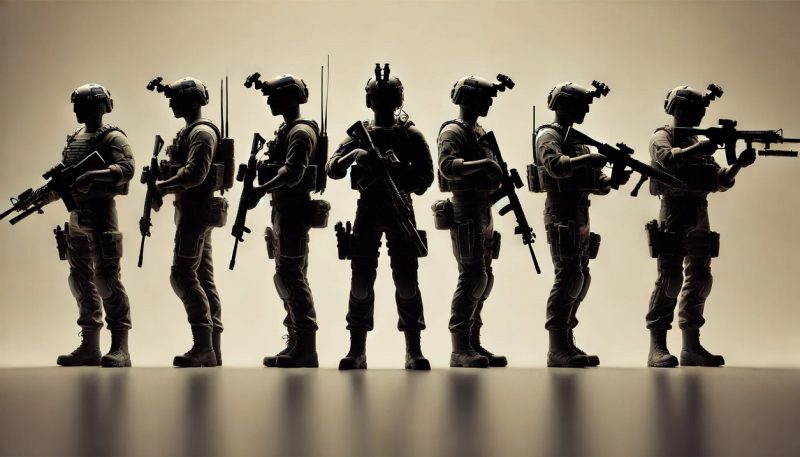Basic Underwater Demolition/SEAL (BUD/S) training is the first step to becoming a Navy SEAL. Accessing the BUD/S is the first step and probably the most difficult on the way to becoming a part of an elite naval special operations forces unit. Today, there are around 3,000 SEAL operators divided into eight (8) SEAL teams. They represent less than 1% of overall active-duty personnel in the United States Navy.
Introduction
As I already mentioned, becoming a frogman isn’t an easy task, but the truth is, it is everything except easy. Every candidate who fulfils basic requirements needs to spend over a year in a series of formal training environments before being awarded the Special Warfare Operator Naval Rating and the Navy Enlisted Classification (NEC) 5326 Combatant Swimmer (SEAL) or, in the case of commissioned naval officers, the designation Naval Special Warfare (SEAL) Officer. Once upon a time, someone said that it is easier to climb Mount Everest than to finish Basic Underwater Demolition/SEAL (BUD/s).

Basic requirements
Even before the candidates are sent to the BUD/s, they need to meet certain criteria. Candidates are men aged between 18 and 29 who are already a member of the Navy because SEAL team members are exclusively male and recruited only from the US Navy. Sometimes, there are some exceptions for waivers available for 17-year-olds with parental permission and on a case-by-case basis for 29- and 30-year-olds.
No woman has ever become a Navy SEAL. But, since December 2015, women have been allowed to enter the SEAL training pipeline, but they need to provide that they can meet the same acceptance guidelines as men.
Academically, all candidates must have the equivalent of high school education, have a composite score of at least 220 on the ASVAB, and be proficient in all aspects of the English language. Medically, all potential applicants must have at least 20/75 vision, correctable to 20/20, be able to pass the SEAL Physical Screening Test, and have no recent history of drug abuse.
Lastly, applicants must have “good moral character,” as determined by their history of criminal convictions and civil citations.
SEAL Physical Screening Test (PST)
To get into the BUD/s class, the candidate needs to beat PST. Prospective candidates are expected to exceed the minimum. The minimum requirements to successfully pass the PST are:
- 500 yd (460 m) swim using breast or combat sidestroke in under 12:30 with a competitive time of 9:00 or less;
- at least 50 push-ups in 2 minutes with a competitive count of 90 or more;
- at least 50 sit-ups in 2 minutes with a competitive count of 90 or more;
- at least ten pull-ups from a dead hang (no time limit) with a competitive count of 18 or more;
- run 1.5 mi (2.4 km) in running shorts and boots under 10:30 with a competitive time of 9:30 or less.
Once the candidate fulfils basic requirements and successfully passes PST, he is sent to a crash course in the physical standards required even to become a SEAL.
Naval Special Warfare Preparatory School
The so-called crash course is held at Naval Special Warfare Preparatory School in Great Lakes, Illinois, where the candidates are subjected to the opening Physical Screening Test. It ends with a more difficult Physical Screening Test, including a timed four-mile run and a timed 1,000-meter swim.

The aim is to increase the SEAL candidates’ physical readiness between the two tests so that they are ready to move on to Basic Underwater Demolition/SEAL (BUD/S) Training. Those candidates who cannot pass the final test at Naval Special Warfare Preparatory School are removed from the SEAL training pipeline and reassigned to other units inside the Navy. The Naval Special Warfare Preparatory School lasts for eight weeks.
BUD/s class
The Basic Underwater Demolition/SEAL (BUD/s) training lasts for 24 weeks, and it is intended to develop the SEAL candidates’ mental and physical stamina and leadership skills. The course of the training is divided into three phases:
- Phase 1: Physical conditioning (7 weeks)
- Phase 2: Combat diving (7 weeks)
- Phase 3: Land warfare (7 weeks)
Before Phase 1, candidates are sent to the 3-week long BUD/S orientation, previously known as Indoctrination. During this time, candidates learn about the Naval Special Warfare Center and the BUD/S lifestyle. Through basic presentation, Navy SEAL instructors introduce candidates to BUD/S physical training, the obstacle course, swimming, and other unique training aspects. They are preparing candidates for day one of the first phase.
Phase 1: Physical conditioning
As the name suggests, the first phase of BUD/S is dedicated to physical conditioning, water competency, teamwork, and mental tenacity for seven weeks. The instructor makes assessments of every SEAL candidate through daily running, swimming, and callisthenics. As the week progress, the time requirements decrease.

During Phase 1, candidates are divided into six to seven people with one small Inflatable Boat known as IBS. Those teams are called “boat crews,” They must paddle out from the shore, through the surf zone, and back again. Candidates participate in weekly 4-mile (6.4 km) timed runs in boots and pants (now changed to shorts and sneakers) and timed obstacle courses, swim distances up to two miles wearing fins in the ocean, and learn small boat seamanship.
All the time, candidates need to meet specified time requirements for the running and swimming tests or be dropped from the training. The first three weeks of the basic conditioning phase prepare candidates for the fourth week, known as “Hell Week.” Hell Week is one of the most challenging quests during the BUD/S, with a high washout rate among the candidates. Because of the challenging requirements, most candidates drop out during Phase 1, with a significant number deciding to Drop on Request (DOR).
The tradition of DOR consists of dropping one’s helmet liner next to a pole with a brass ship’s bell attached to it and ringing the bell three times.
Hell Week
Hell Week is the most engaging part of Phase 1 because candidates are pushed to the limits. They sleep at most four hours per day during the entire week. During Hell Week, every candidate runs more than 200 miles (320 km) and does physical training for more than 20 hours per day. Candidates are not restricted from meals and are fed breakfast, lunch, and dinner.

The remaining three weeks involve acquiring various methods of conducting hydrographic surveys and creating a hydrographic chart while still participating in timed runs and swim tests.
Phase 2: Combat diving
It is also known as the diving phase of the BUD/S. It emphasizes dive physics, underwater skills, and combat SCUBA. Long-distance underwater dives are performed with swimming and diving techniques as a means of transportation. Upon completion, candidates are qualified as competent basic combat swimmers. In this part of the selection, physical training becomes even more intensive than during Phase 1.

During the diving phase, candidates will obtain new skills and learn two types of SCUBA: open circuit (compressed air) and closed circuit. Also, basic dive medicine and medical skills training is provided. The candidates who are not completely comfortable in the water often struggle to pass Phase 2.
* Requirements to pass Phase 2: candidates must complete a timed 2-mile swim with fins in 80 minutes, the four-mile run with boots in 31 minutes, and a 3.5-mile and 5.5-mile swim.
Phase 3: Land Warfare
The third and last phase is reserved for basic weapons, demolitions, land navigation, patrolling, rappelling, marksmanship, infantry tactics, and small-unit tactics. This part of the selection is deliberately connected to the classroom work where the class is taught to gather and process information that will complete the overall mission.
There is a lot of map work, compass, land navigation, and basic weapon skill sets. These skill-sets allow the class to transition from having novice skills to becoming more comfortable out in the field. Most of this training is new to the class, and the learning pace becomes faster and faster.

Phase 3 lasts for five weeks, where the remaining candidates are sent from Coronado to San Clemente Island. There, they practice the skills they learned in the third phase. The days become longer and more work-intensive, set to mirror the work hours spent in the field. According to the candidates, this is one of the most complex parts of training. Training is conducted seven days a week, with minimal sleep, while handling live explosives and ammunition. Interaction with instructors is also never-ending, and punishments are at their harshest levels yet.
* Requirements to pass Phase 2: candidates must complete a timed 2-mile ocean swim with fins in 75 minutes, a 4-mile timed run with boots in 30 minutes, and complete a 14-mile (23 km) run.
Deaths in training
Yes. People die in all manner of military training. The military takes extraordinary precautions to keep personnel safe, and deaths are rare considering the numbers of people in the various branches of the undergoing military training, but they do happen. Jeeps roll over, planes and helicopters crash, and equipment (much of which is specifically designed to kill) fail.
Sometimes procedures are not followed. Over time, more than one trainee had died when they panicked throwing an armed grenade, dropped it into the pit next to themselves, and froze rather than kicking it into the grenade trap at the bottom of the pit or jumping out of the pit.
People training in infested areas occasionally gets bitten by snakes. Parachutes fail to open properly for reasons nobody can ultimately discern (scarce… but it happens). People drown when they get caught in riptides or get smashed against rocks when a sudden explosive wave throws them against them.
The military goes to great lengths to make training safe. But in the end, you are participating in potentially dangerous activities, often using equipment fundamentally designed to kill, and accidents will happen. It’s the cost of doing business. In all, the US military loses an average of, say… One hundred soldiers, sailors, airmen, and Marines in training accidents annually.
Oldest SEAL to complete BUD/S
Specific information about the oldest SEAL to complete BUD/S is not available to the public. But, a man quit BUD/S when he was 19 because his fiance didn’t want him to be a Navy SEAL. He lived his life with the thought of BUD/S always in his mind, so he decided to try again and get wavier after 20 years. He graduated from BUD/S class when he was 39, according to the book Warrior Elite by Dick Couch.
Perry F. Van Hooser went through BUD/S class 137 when he was 36 and served 26 years as a SEAL. He was also a vice president of ACADEMI.
Rate of advancement through BUD/S
| Completed BUD/S phase 1: | 33% of candidates |
| Completed BUD/S phase 2: | 87% of candidates |
| Completed BUD/S phase 3: | 96% of candidates |






